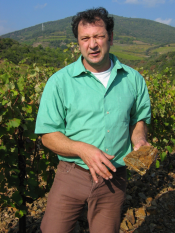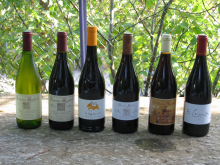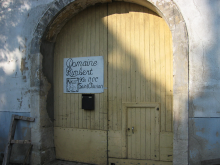 BERLOU, France — Jean-Marie Rimbert came late to wine. He was born into a farming family in Provence, but the cash crop was fruits other than grapes. Jean-Marie was an artist at heart and needed a forum to express himself.
BERLOU, France — Jean-Marie Rimbert came late to wine. He was born into a farming family in Provence, but the cash crop was fruits other than grapes. Jean-Marie was an artist at heart and needed a forum to express himself.
He chose wine, but land in Provence was prohibitively expensive. He found his niche 11 years ago in this small village (population 185) in the Languedoc.
Domaine Rimbert is a rugged 35 hectares (roughly 100-plus acres) in Saint-Chinian, a choice AOC within the larger region of Languedoc-Roussilon in southwestern France.
And the vineyards of Berlou are classified cru, which is another step up from the AOC. The prior owners sold their grapes to the cooperative of Saint-Chinian, but Rimbert saw a higher calling for these vines planted in schist and chalk and protected from the elements and dramatic weather shifts by mountains to the north and east.
“I wanted to make something with my own name on it,” he said (through an interpreter) of his desire to produce wine. “I wanted to be independent. I wanted to create something. I create the wine, the labels, everything. Also, as winemakers, we create the landscape.”
 Rimbert did indeed create everything at Domaine Rimbert, including the labels, which he drew with his own hand. Rimbert’s labels are colorful and whimsical, full of meaning, such as the La Carignatora (“I invented this term,” he says) ‘Le Chant de Marjolaine” that is named after his daughter.
Rimbert did indeed create everything at Domaine Rimbert, including the labels, which he drew with his own hand. Rimbert’s labels are colorful and whimsical, full of meaning, such as the La Carignatora (“I invented this term,” he says) ‘Le Chant de Marjolaine” that is named after his daughter.
Le Chant de Marjolaine is 100 percent Carignan, which is the historic grape of Berlou.
“The identity of cru Berlou must be Carignan,” he says. “Carignan is the grape of Berlou.
Both the Le Chant de Marjolaine and the eclectic “El Carignator II” are 100 percent Carignan, which is rare in the Languedoc, and as such fall outside the rules of the Saint Chinian AOC. Thus, they are Vin de Table wines and not allowed to display the vintage.
Rimbert finds a way, however, and the 2006 Le Chant de Marjolaine ($14) is a spicy, deeply colored red that is both ripe and fresh, with firm tannins that bode well for a long life. It is made from only the best lots from his 80-year-old Carignan vines.
El Carignator II is the second edition of a 100 percent Carignan that blends together five different vintages. The one I tasted was 2000, ’01, ’02, ’03 and ’05.
It is smooth and well balanced, with a touch of spice on the nose and loads of red fruit on the palate. This is a spectacular wine, but so far only sold in Boston among U.S. cities. It retails for about $35.
 Rimbert also produces several red blends that are based on the Carignan, but with amazing old-vine Grenache, and Syrah that has been planted in the past 20 years. He also makes a lovely white that is a fresh and well balanced blend of Marsanne, Roussanne, Carignan blanc, Grenache blanc and Vermentino.
Rimbert also produces several red blends that are based on the Carignan, but with amazing old-vine Grenache, and Syrah that has been planted in the past 20 years. He also makes a lovely white that is a fresh and well balanced blend of Marsanne, Roussanne, Carignan blanc, Grenache blanc and Vermentino.
The Domaine Rimbert wines won’t be easy to find. They are distributed in cities throughout the U.S., but only in small quantities. For the price, however, they represent tremendous value. These red wines are grown in one of the world’s greatest terroirs for the Rhone grape varieties.
8
